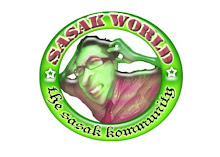White sand beaches, bright blue skies, traditional architecture and local delicacies are what you expect from this island.
white sand and fewer tourists.(JP/Tifa Asrianti)
Transquility: Kuta beach of Lombok offers
Are you imagining Bali? Perhaps you should start thinking about Lombok in West Nusa Tenggara as an island that offers different adventures with the same beautiful attractions that Bali does.
Lombok is different from Bali. It has a different type of beach, a different language and, of course, different cuisine for you to savor.
Recently, I had a chance to travel around the northern and southern parts of Lombok. The reliability of public transport in Lombok is as poor as it is in Bali, so be prepared to rent a motorcycle or a car for long trips, especially if visiting remote places is included in your itinerary.
As for a fun short trip around the city of Mataram and Senggigi, you can take a cidomo, a small horse-drawn cart, a traditional yet environmentally friendly form of public transportation.
On my first day, I visited Narmada Park in Narmada district, a popular tourist destination. King Mataram Lombok, Anak Agung Ngurah Karang Asem, built the park in 1727, hoping to recreate Mount Rinjani in miniature.
A number of pools and a Hindu temple were built in the park, but the most interesting part of the site is probably the Youth Fountain.
The Youth Fountain is nothing like the one in the Pirates of the Caribbean. It is a strong stream of flowing water located in a small hut that is guarded by a Hindu priest.
People in Lombok believe that the water has essential minerals that are good for your body and – believe it or not – keep you young. Local wisdom forbids women who are menstruating from entering the hut.
The priest prayed for a while as we sat on the high floor. After finishing the prayer, he allowed two of us to go down the small fountain, pray shortly, wash our faces and drink a glass of water.
The water was cold and fresh, washing away all the thirst that previously struck me before entering the hut.
We climbed many stairs to reach the top of the place and enjoyed beautiful natural scenery while eating durian, drinking local coffee and eating boiled melinjo (oats) and sweet potatoes.
Durian can be as expensive as Rp 75,000 (US$8.20) or as cheap as Rp 25,000, depending on the season. The best time to visit Pusuk to enjoy durian is between June and August.
After passing Pemenang, the road was flat. We enjoyed mountainous scenery and peanut fields on our right and the blue sea and coconut trees to our left.
The small road along the way was quiet and smooth as there were not many vehicles. We passed several small villages, including Kayangan and Bayan. The houses had modern architecture that was very different from the traditional houses of Lombok.
However, every house had a bale bengong or gazebo where people would sit, talk, watch their children or dry their clothes.
Our main destination was Pondok Senaru (Senaru cottage), a hilltop restaurant. We were excited because we thought we could enjoy Sindang Gile waterfall as the main scenery. The restaurant was nice, and had two ways for diners to enjoy their food — tables and gazebos.
We ate in two big gazebos in the backyard. Adi, our waiter, asked whether we would eat Sasak style, which was called begibung, in which three people would sit around and eat together.
The Sasak are the indigenous people of Lombok. Adi said Sasak women usually wore sarongs while men sported sapuk small head cloths.
“A sapuk is worn in order to give good and orderly impression,” he said.
We ate traditional food from Lombok: plecing kangkung (water spinach and bean sprouts with chili sauce), sate lilit and ayam taliwang (spicy grilled chicken).
The Sindang Gile waterfall might be a majestic 50-meter high waterfall, but it turned out that it was located too far away from the restaurant. It appeared like a small stream of water going out from the hills.
On the way back to Senggigi, we dropped by Sira beach. The beach was surrounded by coconut trees and did not look appealing as green leaves and seaweed were scattered around during low tide.
However, numerous local people got their hands dirty by walking on the beach, hunting for something, picking it up and putting them in plastic bags.
Suberiah, a local woman who had just came back from the beach, said people were ngeremis, or collecting clams to cook.
“They are delicious. I usually boil them with a pinch of salt and some ingredients for our family dinner,” she said while proudly showing a small black plastic bag full of clams.
We headed to Malimbu cliff, a highland area near Senggigi, to watch the sunset and eat grilled corn. The sunset was especially awesome as we could see majestic Mount Agung in Bali and the three small famous Gili islands.
On our third day, we went to the southern part of Lombok, visiting only one main destination – Kuta Beach, famous for its grainy white sand and clear blue skies.
The children who sold souvenirs were annoying as they tailed us around, but the beauty of the beach satisfied us.
Three days were not enough to enjoy Lombok, which offered Mount Rinjani and other destinations to explore. At least, those few days assured me that Lombok was an island worth a visit.
How to reach Mataram in Lombok:
Selaparang airport in Mataram handles international arrivals and offers visas on arrival. Garuda Indonesia, Lion Air and Batavia Air have direct flights from Jakarta to Mataram, while Merpati Nusantara, Trans Nusa and Wings Air have direct flights from Denpasar to Mataram. Silk Air also offers a direct flight from Singapore to Mataram.
Accommodation:
There are many hotels and resorts in Senggigi. Low-cost hostels are available in the capital city of Mataram.









Tiada ulasan:
Catat Ulasan